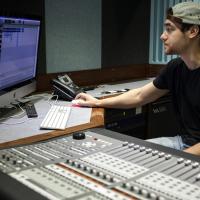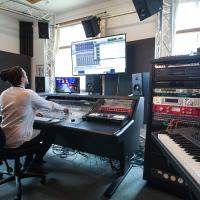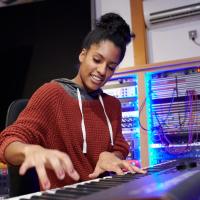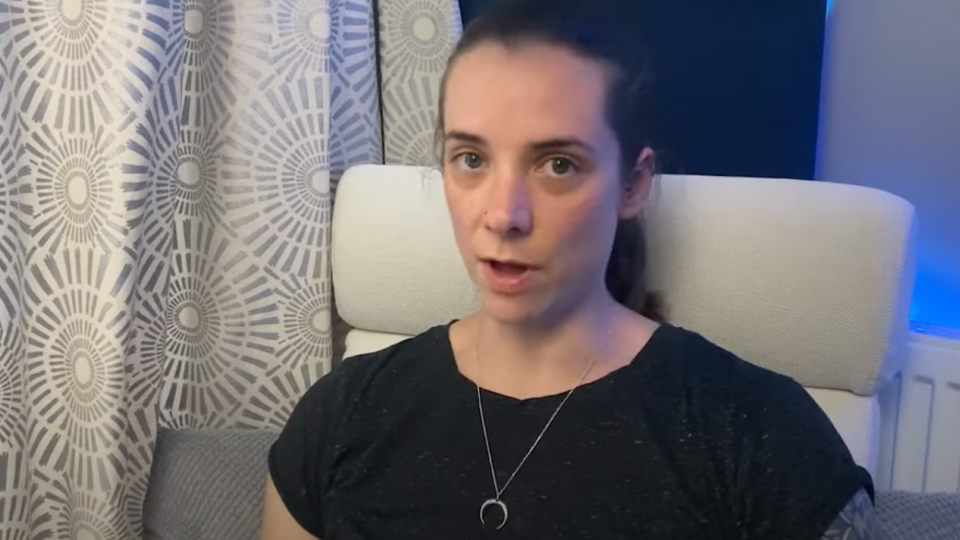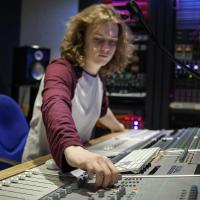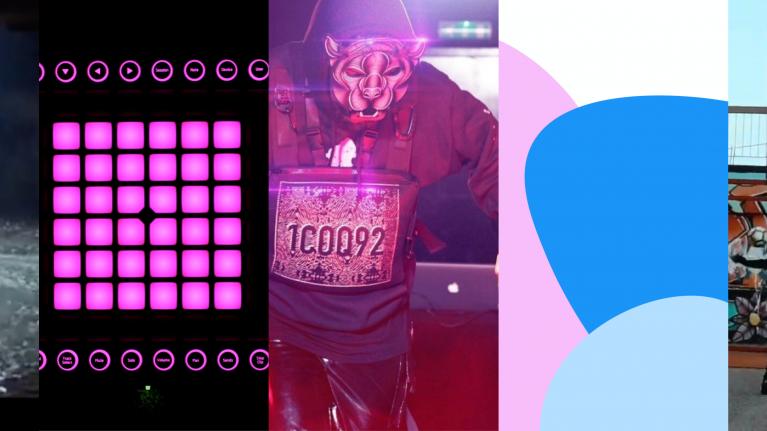Intro
Welcome to Music Technology at the University of West London.
Explore a diverse and exciting range of outcomes from our students.
Jump to:
BA (Hons) Electronic Music Production
Jack Mercer
Jack Mercer, BA (Hons) Electronic Music Production, Major Project ’How can I better understand the music production techniques and approaches of Alix Perez through my own practice’, has lead to the creation of “Sustenance”.
Roger Sesena Mirada
Roger Sesena Mirada
Roger Sesena Mirada, BA (Hons) Electronic Music Production, embarked on an ambitious project as part of the Creative Collaboration module. He project managed 15 collaborators ranging from drone pilots through to dancers, cinematographers, directors and other students from the BA (Hons) Electronic Music Production course. The result is music video about a dancer who feels lonely and depressed. As the music video progresses, she is having some flashbacks of when she danced with other people, and she felt happy and complete.
Roger says, 'I want to thank the entire team at the University for encouraging us to carry out an assessment as important to our artistic development as this one. I believe nowadays, one of the most important talents is knowing how to select the people with whom you are going to work and lead the team so that each member contributes additional value to the project.'
Livelectric
Livelectric
The Live Electronics module on the BA (Hons) Electronic Music Production degree course at LCM are proud to collaborate with the Youth Production Network on this live streamed performance of emerging artists.
Working closely with YPN has given the students a fantastic real-world experience, which has enhanced their academic journey in this fast-moving field of music production and live performance.
Niamh Sygrove
Niamh Sygrove
Niamh Sygrove, BA (Hons) Electronic Music Production, says, 'My project focuses solely on creative collaborations executed by womxn.' The term ‘womxn’ is intended to be 'inclusive of people who identify as neither male nor female - but instead as gender-fluid, gender-queer, gender non-conforming or non-binary'.
In previous parts of life, the term ‘woman’ was spelt ‘womyn’ to 'denounce the man in the word woman’. Intentions behind the altered spelling were to 'imply that a woman’s identity isn’t reliant on a man, and would denote self-determination.'
Womyn was then later altered to womxn after receiving backlash from the LGBTQIA+ community, as well as people of colour, as it 'further widens the metaphorical tent' (Heinrichs, 2019).'
Course links
-
BA (Hons) Electronic Music Production (West London Campus)
West London Campus
Mark Parmiter
Mark Parmiter
Mark Parmiter, BA (Hons) Music Technology, says, "The aim of this project was to create a high-quality virtual instrument from a Bechstein A1 grand piano using Kontakt 6. This project was chosen largely because of my personal connection to the piano itself; a relative’s piano and the first instrument I ever learnt to play, making it one of the first introductions I had to playing and creating music. With this in mind, and with the world becoming increasingly tech based, I wanted to have a virtual copy of this instrument that could be preserved perhaps even longer than the instrument itself. I also wanted easier access to the piano for use in compositions.
The process involved recording the piano with professional microphones and techniques, editing these recordings down carefully to singular notes, and finally building the instrument itself using Native Instruments’ Kontakt 6 software."
Redler Mpembe
Redler Mpembe
Redler Mpembe, BA (Hons) Music Technology, is remotely interviewed by Daniel Pratt about his time studying at LCM.
Bradley Palmer
Bradley Palmer
Bradley Palmer's (BA (Hons) Music Technology) Major Project looks at 'Constructing a Hybridised Production Style: The Sonic Aesthetic of 1970’s Soft Rock Explored Using Contemporary Production Techniques.’
Bradley says, ‘The aim of this project was to construct a hybridised production style by fusing the sonic aesthetic of 1970s Soft Rock with contemporary standards of clarity, punch and sonic interest.
Focusing on the deadened ‘warmth’ of artists such as Eagles and Fleetwood Mac, I undertook research on salient practitioners to uncover the era-specific production techniques responsible for such revered tones
In doing so, I have produced 5 sonically retrospective tracks branded with impactful and intriguing identities, offering the timeless sound of analogue tape on musical steroids.
Existing practitioners Mark Ronson and Jonathan Rado lead the retro-maniacal charge, with their ability to resurrect archaic sounds and repurpose them for the modern age proving a highly inspirational factor when undertaking this project.
By employing the talents of songwriter Will Crane, I have been able to explore said paradigm and create a body work that emulates the sepia hue of the 1970s, manipulated in ways considered impossible at the time.’
-
Read about the effect of lockdown on Bradley's project
In response to Lockdown, Bradley needed to make some project amendments and says,
‘The most notable project amendment made post-Coronavirus was that outstanding parts had to be recorded in isolation. Will recorded additional vocal parts remotely using an AKG D7 in a makeshift vocal booth, whilst I recorded backing vocal and percussion parts with a Shure SM57 in my bedroom.
This circumstance proved serendipitous as the smudged transient response provided by the dynamic mics was ideal for emulating a vintage sonic palette, even surpassing the suitability of the Neumann U87.
Additionally, my plan to record synth/keyboard parts was scuppered as I no longer had access to the hardware required to do so, concluding that the loss studio-based spontaneity would render the endeavour fruitless. Although the absence of synthesis meant losing a valuable means of conveying contemporary sonic interest, the excess space on the frequency spectrum encouraged a guitar-centric mix style, where modulation effects could be used to coax said parts to the forefront.
I was also scheduled to record strings for ‘John Martyn’ and ‘Ollie Chord’, but unfortunately the Coronavirus pandemic saw that this session was cancelled. On a positive note, the opportunity motivated Will and I to compose the string parts, meaning that we can provide scores to string players for post-submission overdubs to fulfil our initial vision.’
George Pallister
George Pallister
George Pallister, BA (Hons) Music Technology, worked on the composition of a short film called Nursing in the Community, exploring the techniques used in modern cinematic composition and sound design to heighten the impact of the soundtrack on the audience.
Course Leader, Sam Sutton, was able to offer George this professional opportunity through industry contacts.
The film received special mention in the WHO Health for All Film Festival in Geneva.
Harrison Lloyd
Harrison Lloyd
Harrison Lloyd, BA (Hons) Music Technology - Audio Post Production.
An examination of techniques of marketing and monetising urban music as a producer in 2020.
Edwyn Ochieno
Edwyn Ochieno
Edwyn Ochieno, BA (Hons) Music Technology, has created a show for BBC Radio World Service called Destination Africa.
George Pallister 2019
George Pallister
BA (Hons) Music Technology - Audio Post Production student, George Pallister, composed music for the UWL Winter Graduation Ceremony in 2019.
Course link
-
BA (Hons) Music Technology (West London Campus)
West London Campus
BMus (Hons) Performance and Recording
Sophie Bowler
Sophie Bowler, BMus (Hons) Songwriting and Recording, known as Sophie Marie when working as a top-line vocalist, embarked on a project that explores various collaborative methods, to discover which techniques are the most productive within the EDM community and to establish the best working environments for a producer and top-liner collaboration.
She created a six track EP working with six different producers from around the world including Miami, Belgium and London. Sophie utilised new collaborative apps, such as Vampr, to allow remote collaborations to be easily accessible during the COVID 19 pandemic, whilst allowing her musical knowledge and skills to continuously grow.
Listen to Sophie's work on Spotify:
Sam McDonald
Sam McDonald
Sam McDonald, BMus (Hons) Performance and Recording, says, “As an arranger, I have always considered the most important asset in a musician's toolbox of skills is the ability to dive into an artist’s head and reverse engineer their creative process as a way to think from different points of view.
This collection of songs takes this process to the extreme and transforms the lyrics and structures from the UK’s most prolific singer/songwriter into the style of the great Bruce Springsteen and his legendary E-Street band. From ‘Born to Run’ to ‘Tunnel of Love’ these songs have captured some of Springsteen’s greatest moments."
"I spent the time researching technological methods to recreate the sounds I needed and one of those was using a 2” tape machine on the vocals, drums and horns to capture the vintage saturation associated with the Springsteen sound.
I also used the very well received Mixing and Mastering bundle from Plugin Alliance to emulate any vintage outboard gear and preamp sound such as the API and the SSL9000 analog channel strips for that high end studio sound.My overall aim with this project was to not only prove my own versatility as an arranger and producer, but also demonstrate the importance of an artist’s individual sub-genre as it is what makes their music timeless and distinctive”
Course link
-
BMus (Hons) Performance and Recording (West London Campus)
West London Campus
BA (Hons) Recording, Mixing and Production
Bartlomiej Weglinski
Bartlomiej Weglinski, BA (Hons) Music Recording and Production, explains his project: Creating Modern Cinematic Productions.
"I started my journey with music as a guitarist mostly active in metal and rock genres. I spent the majority of my teenage years listening to bands representing these styles and at some point, I realised that I was especially drawn to artists whose music incorporated cinematic instrumentation. It was fascinating that despite the fact that the music of the bands I was listening to was not composed to accompany any movie, it delivered an experience that had a similar emotional impact on me as listening to film scores.
Gradually, I became more interested in the cinematic sounds than metal music, which directed my attention to the world of film scoring. This project is a result of my ever-growing interest in the aesthetic of music created for films and games, and ways in which it is composed, produced, and mixed. It focuses on the blended sample approach to producing music with a cinematic aesthetic that retains realistic orchestral sound."
-
Credits
- Composition, Production, Recording and Mixing - Bartlomiej Weglinski
- Co-composer of “Avalanche” - Bartosz Gruchała
- Additional Arrangement for “Avalanche” - Francesco Redica
- Live Vocals - Monika Białogłowy
- Vocals Recording Engineer - Jakub Malinowski
- Live Tenor Horn - Kirsten-Ruth MacDonald
- Live Trumpet - Maria Konior
- Live Violin & Viola - Natalia Wierzbicka
- Photo - Stefania Carli
Kin Leonn
Kin Leonn
Affectionately known as the “ambient boy from Singapore”, Kin Leonn, BA (Hons) Recording, Mixing and Production, is an artist, composer and producer currently based in London. His transportive work as founding member of electronic act ‘midst’, as well as his solo releases on the highly-regarded KITCHEN. LABEL have established him as an exciting, versatile presence within Singapore’s thriving underground.
His varying work and accomplishments include features on KEXP (USA) and BBC Radio (UK), a collaborative ambient EP with Japanese sound artist Hiroshi Ebina, numerous sold-out shows in both London and Singapore, and a 6-channel surround experience in collaboration with London’s Architectural Association.
Course link
-
BA (Hons) Recording, Mixing and Production (West London Campus)
West London Campus
MMus Composition
Sara Almeida Carvalho
"This study investigates particular technical devices that can help produce a dimensional and focal quality in musical composition. The academic research is supported by a body of musical pieces and photographs that put into practice the theoretical discoveries. Research findings revealed that particular musical devices channel a sense of blur and depth in compositions by seminal 20th-century figures. This study analyses and discusses these and puts the knowledge into practice through an artefact containing a set of four original pieces which incorporate the different techniques used by the studied composers, creating innovative notions of musical depth and blur. Some of the devices explored to achieve the intended outcome comprise removing bar lines, creating blurry textures by adding tremolo and trills to the strings and woodwinds, doubling instrument layers, adding reverberation and delay, and creating a dynamics gradient reflective of the pitches in the audio spectrum."
Course link
-
MMus Composition (West London Campus)
West London Campus
MMus Electronic Music Composition
Henri Philip Werner, MMus Electronic Music Composition
Instagram | Spotify | Website
Teresa Morini
Teresa Morini
Heuristic Inquiry: Composing Electronic Music for Neurofeedback using Ableton Live.
"This study aims to explore and understand how electronic music can aid with common ailments such as stress, anxiety, and depression. It is widely known that if these issues are left untreated it can be detrimental to the affected person in their everyday life and at worst, the outcome can be fatal. According to the World Health Organisation (WHO), suicide is the fourth leading cause of death among people aged between 15 to 29 years (World Health Organisation, 2021). This study is concerned with taking preventative measures and empowering people to learn more about how to practice mental well-being and promote good mental hygiene."
HeadSpace
HeadSpace: Binaural Concert
This concert showcases the work of MMus Electronic Music Composition students at the London College of Music, past and present.
Please listen to these pieces using headphones, as they have been composed using binaural audio to provide a spatialised, immersive listening experience.
If you would like to find out more about the Electronic Music Composition course please email larry.whelan@uwl.ac.uk
Course link
-
MMus Electronic Music Composition (West London Campus)
West London Campus
MA Record Production
Tudor Crisan
Identifying and Producing “Ear Candy” Effects and Transitions in Pop Music Productions.
"Aspects of pop-music production such as “Ear Candy” effects (Rodgers, 2021), are the main focus of the Practical component of this Masters thesis. These are often overlooked in discussions about pop-music creation and how the finished result was achieved. In a pop song, transitory “Ear Candy” special effects have the aim to glue the production together and support important moments in the song, such as the pre-chorus or chorus.
Most of the time, “Ear Candy” effects are simple, basic sounds that employ rudimentary sound synthesis or manipulation. The main types of these effects are uplifters, reverse reverbs or delays, impacts, reverse cymbals, but they can also be small vocal chops before the vocal line kicks in or hidden duplicated vocal tracks. Some different types of “Ear Candy” Effects have been investigated and applied on several of my personal pop productions, which made up the practical component of this Masters project."
Amy Ratcliffe
Amy Ratcliffe
Texture and Temporality in Music.
"In the context of this project, I analyse how music can create the sense of temporalities and time through developments in texture. This research project focusses on how three 21st-Century Icelandic media composers, Johann Johannsson, Hildur Guðnadóttir and Olafur Arnalds, create contrasting temporalities through their use of textural variation to create motion and stasis, thereby “sounding motion in temporal space” (Reinhold, 1954, p. 167). Particularly, they focus on the density of the music (the way in which it is layered) and the timbres of instruments and sounds that they use. They manage, through skilful use of devices associated with these two facets of music, to create a sense of movement and stasis within a given piece. These stimuli within the music influence the listener’s conscious perception of time and create new ideas of temporality for the listener; “conscious states, under the influence of the stimuli that come to it from the outside world” (Baggech and Messiaen, 1998, p.31)".
Richard Sanderson
Richard Sanderson
Virtual Collaboration in Music.
"This paper is an auto-ethnographic study into the world of virtual collaborations. Whilst people have been collaborating over the Internet for many years, the rate at which people have been collaborating virtually has increased dramatically due to the necessity brought on by the Covid-19 pandemic. Many musicians who had previously never worked remotely with clients or producers very quickly had to learn a new skill set in order to do their job, and faced potential upheaval in their creative workflow. This study aims to decode the different stages and interactions involved in virtual collaborations to create a guideline of possible ways in which virtual sessions can be run effectively."
Rory O’Connor
Rory O’Connor
A Practice Based Approach to Understanding 80s Pop Production.
"Pop music of the 1980s has such a distinct and recognisable sound that it is often used to sum up the sound of the ‘80s in general. The reification of an entire decade’s musical output into a small number of recognisable sonic signifiers is a consequence of a musical and political climate that saw rapid change and development in the early 1980s. This presents an opportunity to research the hidden or covert factors that may have influenced this sound, and explore how the structure and agency of macro-level influences regulate and determine aesthetic choices that contribute to the association between music and era. By combining practice and research, this project has illuminated a number of ways in which production workflows, emerging technologies and cultural outlook manifested in the pop music of the 1980s to create a distinct and recognisable sound that, to this day, remains evocative of the era."
Jonathan Gaskin
Jonathan Gaskin
Gemma Castle
Gemma Castle
Course link
-
MA Record Production (West London Campus)
West London Campus
MA Advanced Music Technology
Adriaan Kasteleijn
Madeline Ratnavale
Madeline Ratnavale
"To understand to what extent timbre has an emotional effect on sound art compositions, this research utilises a practice-based approach. A preliminary study, as well as further research and development, provided a base understanding of the relationship between timbre, emotion, and sound art so that the creation of the artefact would be well-informed. The artefact created is entitled ‘Grief’, and it consists of five sound-art compositions that represent each of the five stages of the grieving process: denial, anger, bargaining, depression, and acceptance. These pieces have carefully selected timbral elements to display how different timbres result in different emotional outputs. This practice has shown that the extent to which timbre affects a sound-art piece is not necessarily definitive but rather it showcases a need for reflective examination of one’s practice to make tacit knowledge connections about their art that can elevate their practice over time. Additionally, this research has shown the importance of experimentation in practice-based research to fully examine the breadth of possibility that comes with analysing creative-arts practice."
Maurice Marshall
Maurice Marshall
In this interview with Dr Dan Pratt, Maurice Marshall, MA Advanced Music Technology, discusses his creativity, the struggle of contracting COVID 19, and his return to the Masters degree after being away from the UWL community due to his extended hospital stay.
Pichak Siripanich
Pichak Siripanich
"Sonification plays an essential role in the world of the sound art installation. However, it is often underrated if the focal point of a project revolves around the human performer. Therefore, this project combines live data mining and audio processing to autonomously emphasise the sonification. The approach to building a sonification installation or a sound sculpture involves electronic components and data mapping. A previous literature review of the artists Bill Fontana and Nuria Bonet suggests using pre-recorded sounds in the playback and mapping process. Rafał Zapała (2014) stated that the problem of 'live electronic preparation' is associated with the fixed duration of pre-recorded sounds when combining acoustic and electronic audio. Because the playback time of a sound file is fixed, it needs to change, he proposed that the solution for a change is the 'live interaction' between the acoustic and electronic audio within an installation. A live electro-acoustic preparation, this sonification project can perform and make recordings on its own."
James Thurling
James Thurling
James Thurling, MA Record Production, says: ‘Producing The Beatles in 2020’ - was a practical and research based undertaking whereby I set about recreating eleven Beatles tracks spanning their eight year career at Abbey Road Studios, with each track demonstrating a unique recording and/or mixing innovation. These innovations were originally realised by George Martin, the EMI engineers and The Beatles using the technology and equipment of Abbey Road in the 1960’s. I wanted to see if I could recreate these innovations using a digital audio workstation (DAW), plugins and the instruments I had at my disposal in a home studio environment and prove that you can in fact recreate recording innovations of the past at relative convenience using a DAW.
I learned, recorded, mixed and mastered all eleven tracks in Pro Tools using an array of plugins modelled after the Abbey Road analog equipment during the summer of 2020. The results show that yes - you can recreate the innovations of The Beatles using only a DAW, but not only that - the project and experiments further suggest the potential and rise for home based music production work, especially during the Covid-19 Pandemic. The overarching question this project suggests is that there is a discussion to be had about the need for professional recording studios when home studios offer viable solutions to starting musicians and producers - whether it be financial, logistic or artistic by choice.
LinkedIn | Instagram | YouTube | SoundBetter
Folly den Toom
Folly den Toom
Folly den Toom, MA Record Production - Organic Overdubbing & The NEDMOOT Method.
Folly says, “Motivated by growing personal frustrations with the (depending on the genre) unbefitting sound of recordings entirely constructed from overdubs, I decided to investigate how I could make non-linear performances sound more ‘organic’. By ‘organic’ I am referring to the mysterious variables that constitute the unmistakable sound of records from a bygone era, in particular records from the 1970s. Although overdubbing was already standard practice by this time, recordings were often constructed on top of a basic Rubato performance, which in fact featured multiple agents interacting.'
'Overall, my research project showed me that there is much more to group interaction than just discrepancies in timing and tempo, aspects I initially focused on given the widespread use of click tracks for overdubbing today. Given its inductive nature, the research didn’t lead to any definitive results regarding how to replicate the sound of a group performance. Notwithstanding, it did produce interesting results and concepts that are useful for my own practice going forward, and have inspired further investigation in future research.”
Course link
-
MA Advanced Music Technology (West London Campus)
West London Campus
MMus Composition for Film and Television
George Hinson
Texture and Temporality in Music.
"In the context of this project, I analyse how music can create the sense of temporalities and time through developments in texture. This research project focusses on how three 21st-Century Icelandic media composers, Johann Johannsson, Hildur Guðnadóttir and Olafur Arnalds, create contrasting temporalities through their use of textural variation to create motion and stasis, thereby “sounding motion in temporal space” (Reinhold, 1954, p. 167). Particularly, they focus on the density of the music (the way in which it is layered) and the timbres of instruments and sounds that they use. They manage, through skilful use of devices associated with these two facets of music, to create a sense of movement and stasis within a given piece. These stimuli within the music influence the listener’s conscious perception of time and create new ideas of temporality for the listener; “conscious states, under the influence of the stimuli that come to it from the outside world” (Baggech and Messiaen, 1998, p.31)"
Course link
-
MMus Composition for Film and Television (West London Campus)
West London Campus
Education in Isolation podcast
Our UWL lecturers, Ben Bushell and Dr Dan Pratt, have produced an Education in Isolation podcast. In this episode, Dan and Ben interview Jackson Walkden-Brown, manager of Tones and I, the most streamed female artist in history.
The interview cycles through a range of subjects including all things management, artist development and relationships, entertainment law, and the impact of COVID 19 on an internationally touring artist
DISCOVER
-
ARTSFEST students' work
Highlights of final year students' portfolios and showreels from the London School of Film, Media and Design and the London College of Music.
-
ARTSFEST Music Performance and Composition
Welcome to Music Performance and Composition. Explore a collation of work from our graduates and current students.
-
ARTSFEST Performing Arts
Welcome to Performing Arts. Explore a diverse and exciting range of outcomes from our students.
-
ARTSFEST Film, Media and Communication
Explore highlights from our students within Film, Media and Communications.
-
ARTSFEST Visual Effects, Photography and Design
Explore the exciting outcomes from our photography, visual effects and graphic design students.
-
ARTSFEST Fashion
Welcome to highlights from our fashion students.




